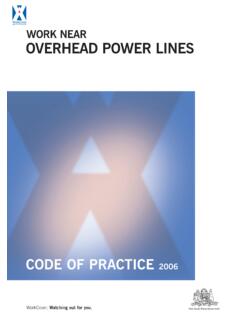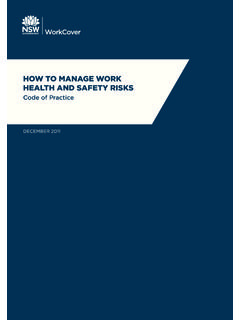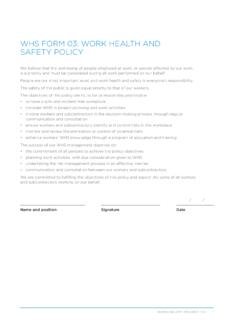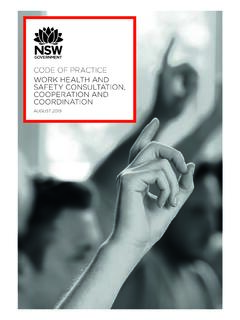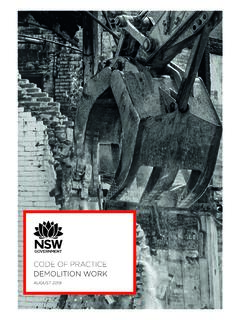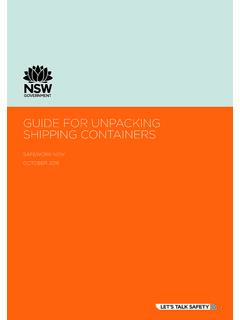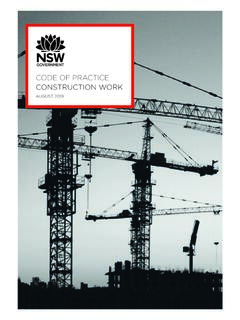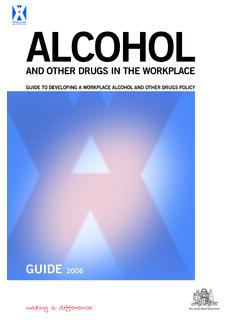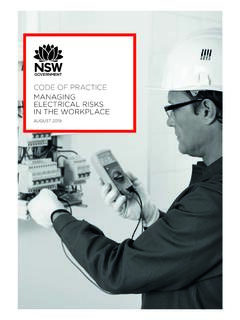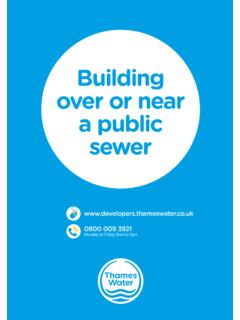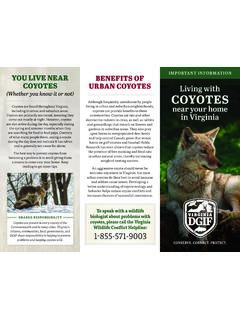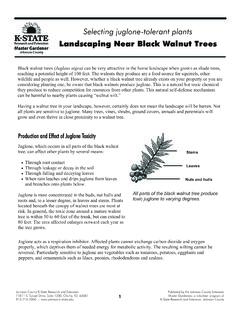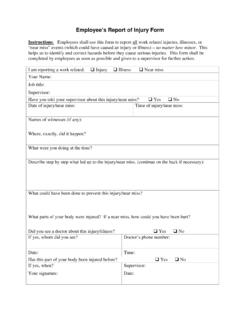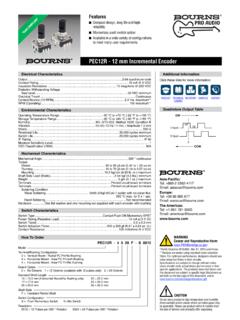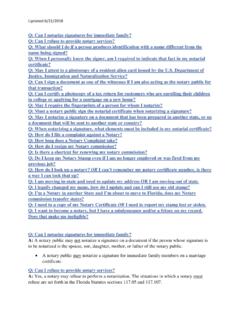Transcription of WORK NEAR OVERHEAD POWER LINES - SafeWork NSW
1 WorkCover. Watching out for South Wales GovernmentWORK NEAROVERHEAD POWER LINESCODE OF PRACTICE 2006 DisclaimerThis publication may contain occupational health and safety and workers compensation information. It may include some of your obligations under the various legislations that WorkCover NSW administers. To ensure you comply with your legal obligations you must refer to the appropriate on the latest laws can be checked by visiting the NSW legislation website ( ) or by contacting the free hotline service on 02 9321 publication does not represent a comprehensive statement of the law as it applies to particular problems or to individuals or as a substitute for legal advice.
2 You should seek independent legal advice if you need assistance on the application of the law to your situation. WorkCover NSW1 CONTENTS PAGEWHAT IS AN INDUSTRY CODE OF PRACTICE? 4 PREFACE 5 WHAT IS work NEAR OVERHEAD POWER LINES ? 5 PERSONNEL WORKING NEAR OVERHEAD POWER LINES 5 HOW CAN WORKING NEAR LIVE OVERHEAD POWER LINES BE DANGEROUS? 6 WHAT DO THE SYMBOLS IN THE CODE OF PRACTICE MEAN? 6 ACKNOWLEDGEMENT 6 CHAPTER 1 ESTABLISHMENT Title Purpose Scope Authority Commencement Interpretation Applicable legislation Definitions 9 CHAPTER 2 CONSULTATION AND RISK MANAGEMENT Consultation at the workplace 14 Consultation arrangements 15 Consultation procedures 15 When should consultation be undertaken?
3 15 How should consultation be undertaken? Risk management at the workplace 16 Identify hazards 16 Assess risks 17 Eliminate or control the risk 17 Review risk assessment and control measures Information, instruction, training and supervision Provision of information 18 Safe work method statements Preparation for work to commence 19 CHAPTER 3 APPROACH DISTANCES WHEN WORKING NEAR OVERHEAD POWER LINES Scope Basis of approach distances? 20 Assessing the relevant approach distance 20 Increases to approach distances 22 How close can I go to OVERHEAD POWER LINES ?
4 Ordinary Person Zone Accredited Person Zone work inside the No Go Zone Approval of the network operator Approach Distances for Vehicles work near OVERHEAD POWER LINES General risk management principles Competence and knowledge of this code 27 Training and Competence Accredited Person 27 Maintenance of competency Safety Observer General requirements 27 CHAPTER 4 OPERATING CRANES AND MOBILE PLANT NEAR OVERHEAD POWER LINES Scope Hazard identification Risk assessment Control measures for cranes and mobile plant operating near OVERHEAD POWER LINES 31 Elimination 31 Separation 31 Administrative controls Workers in contact with the crane.
5 Load or mobile plant 33 Operators 33 Other workers Competency requirements Safety observer for crane and mobile plant operations Earthing systems for cranes and mobile plant Notices to be fixed to cranes and mobile plant 35 CHAPTER 5 TREE AND VEGETATION MANAGEMENT NEAR OVERHEAD POWER LINES Scope Hazard identification and risk assessment Eliminating or controlling risks General risk factors Requirements for Ordinary Persons carrying out tree and vegetation management Requirements for Accredited Persons carrying out tree and vegetation management Tree management inside the No Go Zone Approval of the network operator Trees or branches contacting live OVERHEAD POWER LINES 39 CHAPTER 6 work INVOLVING SCAFFOLDING NEAR OVERHEAD POWER LINES Scope Hazard identification Risk assessment Eliminating or controlling risks general risk factors Control measures for the erection and dismantling of scaffolding near OVERHEAD POWER LINES Erected
6 Scaffolding Use of a hoarding for reduced safety clearances 43 CHAPTER 7 AGRICULTURAL work NEAR OVERHEAD POWER LINES Scope Hazard identification Risk assessment Control measures for agricultural work near OVERHEAD POWER LINES 46 CHAPTER 8 work NEAR LOW VOLTAGE OVERHEAD SERVICE LINES Scope Approach distance for work near low voltage OVERHEAD service LINES work inside the relevant approach distance Hazard identification Risk assessment Control measures for work near low voltage OVERHEAD service LINES 50 CHAPTER 9 ADDITIONAL CONSIDERATIONS FOR work NEAR OVERHEAD POWER LINES Tiger tails Notification of incidents 52 APPENDIX 1 Warning notice for OVERHEAD electrical hazards 54 APPENDIX 2 Example of a risk assessment checklist 55 APPENDIX 3 Example Safe work Method Statement 57 APPENDIX 4 Model Training Course Guidelines Safe Electrical Approach Training 60 APPENDIX 5 Emergency procedure following contact with OVERHEAD POWER LINES 62 APPENDIX 6
7 Case Studies of OVERHEAD POWER line Incidents 64 APPENDIX 7 Useful publications 664 WHAT IS AN INDUSTRY CODE OF PRACTICE?An approved industry code of practice is a practical guide to employers and others who have duties under the Occupational Health and Safety Act 2000 (OHS Act) and the Occupational Health and Safety Regulation 2001 (OHS Regulation) with respect to occupational health, safety and welfare. An industry code of practice is approved by the Minister administering the OHS Act. It comes into force on the day specified in the code or, if no day is specified, on the day it is published in the NSW Government Gazette.
8 An approved industry code of practice may be amended from time to time (or it may be revoked) by publication in the Gazette. An approved industry code of practice should be observed unless an alternative course of action that achieves the same or a better level of health, safety and welfare at work is being followed. An approved industry code of practice is intended to be used in conjunction with the requirements of the OHS Act and the OHS Regulation but does not have the same legal force. An approved industry code of practice is advisory rather than mandatory.
9 However, in legal proceedings under the OHS Act or OHS Regulation, failure to observe a relevant approved industry code of practice is admissible in evidence to establish an offence under the OHS Act or OHS WorkCover Authority inspector can draw attention to an approved industry code of practice in an improvement or prohibition notice as a way of indicating the measures that could be taken to remedy an alleged contravention or non-compliance with the OHS Act or OHS Regulation. Failure to comply with an improvement or prohibition notice without reasonable excuse is an offence.
10 In summary an approved INDUSTRY CODE OF PRACTICE: gives practical guidance on how health, safety and welfare at work can be achieved; should be observed unless an alternative course of action that achieves the same or a better level of health, safety and welfare in the workplace is being followed; can be used in support of the preventive enforcement provisions of the Occupational Health and Safety Act; can be used to support prosecutions for failing to comply with or contravening the OHS Act or OHS aim of this code of practice is to protect the health and safety of persons from the risks arising when they are working near OVERHEAD POWER LINES and associated electrical apparatus.
